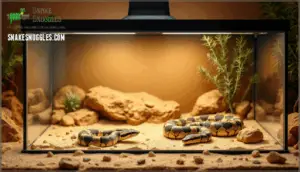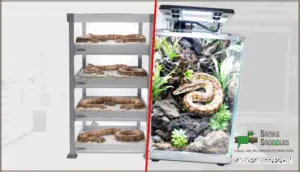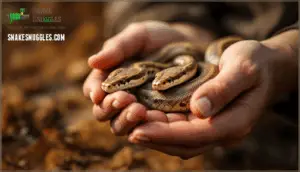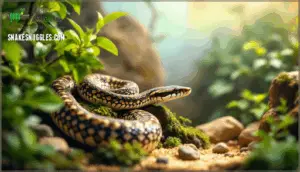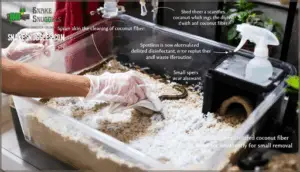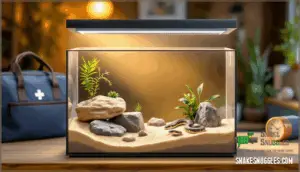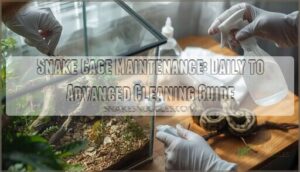This site is supported by our readers. We may earn a commission, at no cost to you, if you purchase through links.
 A Pacific gopher snake (Pituophis catenifer catenifer) can reach nearly six feet in length, yet many prospective keepers underestimate the space, environmental precision, and behavioral expertise required to maintain one successfully. Unlike ball pythons or corn snakes—species selectively bred for docility and forgiving husbandry—gopher snakes retain strong wild-type traits, including defensive hissing, tail vibration, and occasional feeding strikes that startle inexperienced caretakers.
A Pacific gopher snake (Pituophis catenifer catenifer) can reach nearly six feet in length, yet many prospective keepers underestimate the space, environmental precision, and behavioral expertise required to maintain one successfully. Unlike ball pythons or corn snakes—species selectively bred for docility and forgiving husbandry—gopher snakes retain strong wild-type traits, including defensive hissing, tail vibration, and occasional feeding strikes that startle inexperienced caretakers.
Your success hinges on replicating the thermal gradients, humidity parameters, and spatial complexity these colubrids experience across their native range from coastal California to the Great Basin.
This guide translates field biology into practical gopher snake pet care protocols, covering enclosure engineering, prey selection aligned with ontogenetic dietary shifts, and stress-reduction techniques that respect the species’ natural history.
Table Of Contents
- Key Takeaways
- Choosing a Gopher Snake as a Pet
- Preparing The Ideal Enclosure
- Setting Up Substrate and Décor
- Providing Proper Lighting and Heating
- Maintaining Temperature and Humidity
- Feeding and Nutrition Guidelines
- Handling and Socialization Tips
- Monitoring Health and Wellness
- Cleaning and Maintenance Routines
- Ensuring Long-Term Well-Being
- Frequently Asked Questions (FAQs)
- Are gopher snakes good pets?
- How do you care for a gopher snake?
- How do you house a gopher snake?
- Should you bring a gopher snake home?
- Do gopher snakes need to be bathed?
- Can gopher snakes be housed together safely?
- How do gopher snakes behave during breeding season?
- What are typical costs for gopher snake ownership?
- Do gopher snakes require a brumation period?
- How can you determine a gopher snakes sex?
- Conclusion
Key Takeaways
- Gopher snakes demand precise environmental replication—including thermal gradients of 85°F basking to 70–75°F cool zones, humidity below 60%, and UVB lighting—because they retain wild-type physiology that won’t tolerate the forgiving husbandry conditions of selectively bred species like ball pythons.
- Successful feeding requires ontogenetic awareness: hatchlings need 2–5 gram pinkie mice every 5–7 days, while adults over four feet transition to 25–90 gram prey items every 10–14 days, with prey diameter matching (but not exceeding 1.5 times) the snake’s widest body girth.
- Defensive behaviors like hissing, tail vibration, and feeding strikes are species-typical rather than pathological, diminishing predictably through consistent low-frequency handling (1–2 times weekly) that respects the animal’s stress signals and natural history.
- Proactive veterinary care—including annual exams with fecal analysis and blood panels—costs $100–$250 but prevents expensive late-stage disease treatment, while systematic health monitoring (tracking growth, shedding cycles, and behavioral patterns) enables early detection of problems before clinical symptoms emerge.
Choosing a Gopher Snake as a Pet
Gopher snakes aren’t one-size-fits-all—several subspecies exist, each with subtle differences in temperament and appearance that you’ll want to keep in mind before choosing your pet.
You’ll also need to know where to find healthy captive-bred individuals and whether your local regulations allow ownership.
Let’s break down the key factors that’ll help you make an informed decision.
Gopher Snake Subspecies and Temperament
Subspecies variations in Gopher Snakes, such as Pituophis catenifer sayi and deserticola, show subtle differences in coloration and geographic adaptations, but temperament types are remarkably consistent. Most display inquisitive snake conduct, with defensive mechanisms like hissing and tail vibration.
With regular contact, Gopher snake temperament shifts from defensive bluffing to docility, making Gopher snake care manageable for attentive keepers. Understanding their natural Colubridae family traits is essential for providing proper care.
Sourcing and Availability
Once you’ve familiarized yourself with Gopher snake temperament, your next step is sourcing. Breeder Selection is key—captive-bred animals from reputable breeders or Pet Store Options offer reliable health. Online Marketplaces broaden access, but Local Availability often means easier Gopher Snake Care and Maintenance. Import Regulations rarely complicate domestic purchases, making Reptile Care straightforward for most enthusiasts.
Understanding the gopher snake habitat is essential for creating a suitable environment for your pet.
Legal Considerations and Local Laws
After finding a healthy gopher snake, you’ll want to check local laws before bringing one home. Permit requirements vary—from federal laws like the Lacey Act, to state regulations and local ordinances. Enforcement actions can be strict. Ask yourself:
- Is a permit needed?
- Are there limits on snake size or number?
- Are annual renewals required?
Preparing The Ideal Enclosure
Setting up the right home for your gopher snake is the foundation of good care. You’ll want an enclosure that matches their size, habits, and need for security.
Let’s look at your main options for creating a safe and comfortable environment.
Minimum Enclosure Size Requirements
Did you know a gopher snake’s well-being hinges on the right enclosure dimensions? Your adult snake deserves a reptile enclosure design that’s at least 48" x 24" x 24". Space requirements scale with snake length—larger individuals need more. Proper ventilation needs and humidity control guarantee healthy gopher snake housing.
Here’s a quick comparison:
| Snake Length | Enclosure Size | Ventilation Needs |
|---|---|---|
| 3-4 ft | 36"x18"x18" | Moderate |
| 5-6 ft | 48"x24"x24" | High |
| 7-8 ft | 72"x24"x24" | Maximum |
Secure Enclosures and Escape Prevention
Escape artists—gopher snakes are notorious for testing boundaries. Your reptile enclosure design must prioritize Enclosure Security and Escape Proofing.
For peace of mind, focus on:
- Locking Mechanisms that resist prying
- Sturdy Barrier Materials for all seams
- Ventilation Systems that don’t compromise containment
A secure Gopher Snake Enclosure means fewer surprises and safer pets.
Rack Systems Vs. Glass Terrariums
Rack systems excel in space efficiency and humidity control, ideal if you’re managing several snakes or prefer simplified reptile care. Glass terrariums, meanwhile, offer excellent snake visibility and let you create a visually rich vivarium.
Consider your priorities—Enclosure Materials and Ventilation Systems can affect both health and security. The right Gopher Snake Enclosure depends on your lifestyle and goals.
Setting Up Substrate and Décor
Choosing the right substrate and décor makes a huge difference in your gopher snake’s comfort and health. You’ll want to match their natural habits with practical options that work in your setup.
Here’s what you should consider for building a habitat that keeps your snake active and secure.
Recommended Substrate Types
Loose particle bedding, such as aspen bedding or a soil-sand blend, offers ideal burrowing materials and maintains natural moisture control. When evaluating substrate options, prioritize soil quality and humidity levels below 60%.
Gopher snake substrate should allow tunneling but avoid pine or cedar, which can be toxic. You want a bedding that’s safe, clean, and encourages healthy habits.
Creating Hides and Climbing Features
If you want your gopher snake to feel truly at home, providing a network of hides and climbing structures is as essential as giving them room to breathe.
Consider these four essentials for any Gopher Snake Enclosure:
- Hiding Places
- Climbing Structures
- Decorative Rocks
- Branch Arrangements
These elements offer secure hiding spots, vertical spaces, and naturalistic decor.
Safe Plants and Enrichment Items
Adding safe plants and enrichment items to your gopher snake’s enclosure is like turning a simple terrarium into a thriving slice of wild habitat. Focus on Toxic Plant Avoidance by selecting Live Plant Options such as pothos or snake plant.
Integrate Natural Hides, Enrichment Toys, and sensory stimulation to support a bioactive enclosure and ideal Gopher Snake Care.
Providing Proper Lighting and Heating
Lighting and heating play a key role in keeping your gopher snake healthy and active. You’ll need to create the right environment to match their natural habits.
Here’s what to think about when setting up their enclosure.
Daytime Lighting Needs
You’ll want to establish consistent light cycles and photoperiod control, using UVA lighting to create a sense of day and night.
Position basking spots beneath quality UV lighting to encourage natural thermoregulation and activity.
Gopher snake lighting should produce thermal gradients, so your snake can move freely between warmer and cooler zones, just as it would in the wild.
UVB Requirements for Gopher Snakes
UVB lighting plays a critical physiological role in gopher snake husbandry, driving vitamin D synthesis and calcium metabolism. You’ll need a 5–6% T5 High Output bulb—like Arcadia Forest 6% or Zoo Med Reptisun 5.0—positioned 9–15 inches above the basking surface.
This UVB intensity promotes bone development, immune function, and natural activity patterns. Replace bulbs annually to maintain effective output, and use timers for photoperiod regulation: 14 hours summer, 10 hours winter.
Basking Spots and Temperature Gradient
Your basking zone creates the thermal engine that powers digestion, immune response, and thermoregulation—aim for a focused hotspot of 85–90°F beneath an incandescent bulb or halogen lamp, while maintaining a cool-end retreat at 70–75°F. This thermal gradient lets your snake shuttle between zones, selecting ideal body temperature for metabolic demands. Monitor both ends with digital thermometers—never rely on guesswork.
Essential thermal setup components:
- Basking lamp positioned 12–18 inches above substrate—you’ll prevent thermal burns while concentrating heat effectively
- Heat mat as secondary nighttime warmth if ambient temperatures drop below 65°F
- Temperature control via rheostats or thermostats—precision matters for reptile health
- Dual thermometers tracking your temperature gradient across the entire enclosure length
Maintaining Temperature and Humidity
Getting your gopher snake’s environment right isn’t just about the initial setup—you’ll need to maintain the right conditions day after day.
Temperature and humidity work together to keep your snake’s metabolism running smoothly and prevent health problems down the road.
Let’s look at the specific ranges you should aim for and how to monitor them effectively.
Ideal Temperature Ranges
Gopher snakes are ectothermic reptiles that depend entirely on external heat sources to regulate their metabolic processes, making precise thermal management essential for their physiological well-being and long-term survival in captivity.
You’ll need to establish a proper temperature gradient with a basking spot reaching approximately 85°F (32°C) while maintaining the cooler end at 70-72°F (22-25°C). Install your basking lamp at one end to create distinct thermal zones, and use a digital thermometer to monitor both areas accurately.
At night, turn off heat sources to allow natural thermal cycles that mirror conditions experienced throughout their native range.
Humidity Levels and Monitoring
While gopher snakes originate from arid and semi-arid ecosystems across western North America, they still require carefully controlled humidity levels—usually maintained below 60%—to prevent respiratory complications and dermatological issues that commonly afflict captive specimens.
You should install a reliable hygrometer to monitor ambient moisture and utilize shallow water bowls for passive humidity control.
During shedding cycles, provide a humid hide box containing dampened sphagnum moss to aid proper ecdysis without elevating enclosure-wide humidity levels.
Ventilation and Airflow
Proper airflow is essential to prevent the stagnant microclimates that foster bacterial proliferation and respiratory pathogens in captive colubrid enclosures. You’ll want ventilation systems that promote fresh airflow without disrupting your temperature gradient—typically achieved through screened lids or strategically positioned vents on opposing walls.
This air exchange aids humidity control while maintaining breathing space throughout the habitat, affirming your gopher snake’s enclosure remains a healthy, well-oxygenated environment.
Feeding and Nutrition Guidelines
Feeding your gopher snake properly means understanding what prey to offer, how often to feed, and how to manage frozen items safely.
Getting nutrition right promotes healthy growth, steady energy levels, and long-term vitality.
Here’s what you need to know about each aspect of your snake’s diet.
Appropriate Prey Types and Sizes
Rodents form the cornerstone of snake nutrition in captivity, mirroring their status as primary prey in the wild—comprising over 60% of total prey weight. Frozen rodents offer convenience and safety, while prey item variety—including occasional quail—fulfills complete carnivorous diet requirements and prevents nutritional deficiencies in your gopher snake.
You’ll feed hatchlings pinkie mice weighing 2–5 grams, then graduate to adult mice or small rats of 25–90 grams for specimens exceeding four feet. Prey size guidelines recommend matching the widest body diameter of your snake, avoiding items exceeding 1.5 times this girth to prevent regurgitation.
Feeding Schedules for All Life Stages
Juvenile nutrition calls for a slightly longer interval—every 7–10 days—before you shift to an adult diet, with feeding frequency dropping to every 10–14 days.
Prey variety remains vital throughout, promoting your gopher snake diet fosters healthy growth and metabolism.
This feeding guide balances carnivorous diet needs and natural rhythms, allowing you to confidently manage snake feeding and nutrition.
Thawing and Offering Frozen Prey
Have you ever wondered why serving frozen prey at the right temperature is as vital for your snake as a chef plating a gourmet meal? Thawing methods matter—always use warm water for temperature control, securing thawed prey reaches 75–100°F.
Careful prey selection and feeding techniques safeguard food safety, supporting your gopher snake diet and carnivorous nutrition needs outlined in this feeding guide.
Providing Fresh Water
Just as every desert wanderer seeks an oasis, your snake relies on a clean, reliable source of fresh water to thrive in captivity. Prioritize water quality—offer nonchlorinated drinking water, refresh bowls daily, and monitor water temperature.
Hydration tips include:
- Use shallow bowls for easy access
- Clean water bowls weekly
- Avoid chlorinated tap water
- Check humidity regularly
- Replace stale water promptly
Handling and Socialization Tips
Having a gentle touch and knowing when to interact with your gopher snake can make a big difference in their comfort. The right approach helps them learn that your hands aren’t a threat.
Here are the main things to keep in mind as you build trust and confidence together.
Best Practices for Safe Handling
If you ever find yourself reaching into your snake’s enclosure, it’s wise to approach the moment with both patience and a bit of gentle confidence. Support your Gopher snake fully, avoiding sudden movements. Gentle Management and proper Snake Support are essential.
Consider this table:
| Management Techniques | Safety Precautions |
|---|---|
| Two-hand support | Wash hands before |
| Slow, steady movement | Never grab by tail |
| Observe snake conduct | Monitor for stress |
Reducing Stress and Defensive Behaviors
A little patience goes a long way when you’re helping your snake feel safe—and with the right approach, you can keep defensive displays to a minimum.
Try these proven methods for stress reduction:
- Offer Environmental Enrichment—hide boxes or tunnels encourage calm.
- Limit exposure to loud noises.
- Read your snake’s body language; defensive posturing signals the need for space.
Handling Frequency and Timing
Once your snake begins to relax and settle in, knowing when and how often to manage it makes all the difference for building trust. Gentle management just 1–2 times weekly aids snake taming without overwhelming even sensitive temperaments. Consistency, rather than frequency, is key for stress reduction and successful gopher snake management.
| Timing | Management Methods |
|---|---|
| Weekly (1–2 times) | Gentle support, no tail lifting |
| After feeding? | Wait 48 hours |
| While shedding? | Avoid managing |
| Day vs Night | Daytime preferred |
Monitoring Health and Wellness
Gopher snakes do best when you keep a close eye on their health and daily habits. To help you spot changes early, it’s important to know what’s normal and what might signal a problem.
Here are a few key signs and issues to watch for as you care for your snake.
Recognizing Common Health Issues
Think of your gopher snake’s health like reading changing weather. Respiratory issues, subtle skin lesions, metabolic disorders, and sudden fungal infections can crop up fast—especially with poor hygiene or missed Parasite Control.
Staying sharp to shifts in your snake’s conduct or appearance is your strongest defense for supporting reptile health and wellness, and securing long-term Gopher Snake Health and Hygiene.
Signs of Illness or Injury
Nothing rattles your peace of mind quite like spotting those first hints that something isn’t right with your scaly companion. Watch for these classic signs of gopher snake health issues:
- Unusual swelling or wounds (Injury Signs)
- Noisy breathing, excess mucus, or gaping (Illness Symptoms)
- Refusal to eat or sudden lethargy
Prompt veterinary care secures reptile health and wellness.
Shedding and Skin Care
Your gopher snake’s shedding cycle reveals more about its health than you might expect—smooth, complete sheds signal proper humidity and nutrition, while patchy or retained skin waves a red flag. During the shed cycle, your snake’s eyes turn milky-blue before clearing—that’s when humidity management becomes critical.
Boost moisture slightly, monitor for mite control around scale health vulnerable areas, and watch for skin lesions post-shed. Proper reptile health and wellness depends on recognizing when gopher snake shedding goes sideways.
Cleaning and Maintenance Routines
A clean enclosure isn’t just about aesthetics—it’s fundamental to preventing bacterial infections, respiratory issues, and parasitic infestations in your gopher snake. Regular maintenance requires both daily attention and periodic deep cleaning to guarantee your snake’s environment remains hygienic and safe.
Here’s how to establish an effective cleaning routine that protects your snake’s health without causing unnecessary stress.
Spot Cleaning and Deep Cleaning
Maintaining a spotless enclosure isn’t just about aesthetics—it’s your frontline defense against respiratory infections, scale rot, and parasitic infestations that can compromise your gopher snake’s health.
You’ll need two-tiered hygiene practices: daily spot cleaning removes feces, urates, and soiled substrate immediately, while monthly deep cleaning requires complete enclosure sanitation using reptile-safe disinfectant.
This dual approach prevents pathogen accumulation while minimizing contact stress during routine waste removal.
Disinfecting Accessories and Décor
Contaminated furnishings serve as microbial reservoirs that can reinfect even a freshly cleaned enclosure, making proper disinfection of all accessories and décor as critical as substrate replacement itself.
You’ll want to remove hides, branches, and water dishes during deep cleaning sessions, then apply these sanitizing methods:
- Soak non-porous items in 1:10 bleach solution or reptile-safe disinfectant for 10-15 minutes
- Scrub with hot water to remove organic debris before chemical treatment
- Rinse thoroughly and air-dry completely before reintroduction
Accessory sterilization prevents cross-contamination that routine spot cleaning can’t address.
Water Bowl Hygiene
Stagnant water transforms into a pathogen-rich broth within 24-48 hours, making daily bowl maintenance one of your most critical yet frequently neglected husbandry tasks. You’ll need to empty, scrub with hot water, and refill the water bowl every morning—this simple routine slashes bacterial control failures dramatically.
Weekly disinfectant treatments using reptile-safe solutions further guarantee water quality while preventing the humidity-driven mold growth that compromises both freshness maintenance and overall gopher snake care sheet standards.
Ensuring Long-Term Well-Being
Keeping your gopher snake healthy for years to come means staying ahead of potential problems rather than just reacting to them. A proactive approach to care—from routine veterinary visits to careful observation—helps you catch issues early and maintain ideal conditions throughout your snake’s life.
Let’s look at the essential practices that support your gopher snake’s long-term health and happiness.
Regular Veterinary Check-Ups
Scheduling annual health exams with a qualified reptile veterinarian represents one of the most thorough forms of preventive care you can provide. During these visits, your vet will conduct thorough physical assessments, evaluate body condition and hydration, and may recommend diagnostic tests—including fecal analysis for intestinal parasites, blood panels to assess organ function, or radiographs to visualize internal structures.
While veterinary costs for routine reptile health exams usually range from $100 to $250, with additional fees for specialized diagnostic tests, this investment in captive reptile care consistently proves less expensive than treating late-stage disease. Early detection through regular wellness checks markedly improves long-term outcomes for gopher snake health and hygiene, supporting both reptile health and your peace of mind.
Though snake insurance options remain limited compared to traditional pet coverage, establishing a relationship with an experienced exotic animal veterinarian guarantees access to expertise when health concerns arise.
Monitoring Growth and Behavior
Beyond preventive veterinary care, tracking developmental milestones and behavioral patterns throughout your snake’s life provides quantifiable data that helps you distinguish normal variation from potential health concerns before clinical symptoms emerge. Monitor these Health Indicators consistently:
- Growth Patterns: Measure length and weight monthly during development stages
- Behavioral Signs: Note feeding response, activity cycles, and temperament shifts
- Snake Observation: Document shedding frequency and skin quality
- Gopher Snake Management: Track tolerance levels and defensive displays
- Animal Behavior and Psychology: Record seasonal activity changes
These records strengthen your understanding of normal Snake Behavior and Reptile Health and Hygiene, making deviations immediately apparent.
Addressing Special Care Needs
Some gopher snakes require accommodations that fall outside standard husbandry protocols, particularly when dealing with age-related conditions, physical disabilities, or persistent behavioral challenges that compromise their quality of life. Geriatric specimens may need special diets with smaller, more frequent prey items, while snakes with locomotor impairments benefit from modified Snake Habitat configurations featuring low-profile hides and reduced climbing opportunities.
Environmental enrichment strategies addressing abnormal Snake conduct—such as chronic defensive displays or food refusal—often require systematic desensitization protocols combined with thorough Health monitoring to track progress and prevent Injury prevention concerns throughout your Gopher Snake Care journey.
Frequently Asked Questions (FAQs)
Are gopher snakes good pets?
Many keepers find gopher snakes make excellent pets due to their hardy nature and manageable temperament. These nonvenomous constrictors tolerate touch well, especially captive-bred specimens, though individual snake conduct varies.
Their straightforward reptile care requirements suit both novice and experienced pet ownership enthusiasts.
How do you care for a gopher snake?
Proper Gopher Snake care requires maintaining specific environmental parameters through careful snake habitat design. This includes a temperature gradient of 85°F basking to 70-72°F cool zones, UVB lighting for metabolic health, and humidity below 60%.
Additionally, a feeding schedule of appropriately-sized frozen prey every 5-14 days, depending on age, is essential. Regular snake health checks should also be conducted to ensure overall well-being.
How do you house a gopher snake?
Housing these constrictors isn’t rocket science, but treating them like goldfish is a quick path to disappointment.
Housing gopher snakes demands precision and commitment, not the casual approach you’d use for goldfish
Your gopher snake enclosure demands adequate space—think minimum 4x2x2 feet for adults—with secure lids, proper substrate like aspen or cypress mulch, multiple snake hideaways, solid temperature control, and excellent ventilation systems throughout the vivarium.
Should you bring a gopher snake home?
Before committing to pet ownership, consider whether a gopher snake aligns with your lifestyle and expectations. These captive-bred animals require a longevity commitment of 10-15 years, making home preparation and family considerations essential for reptile health wellness.
Do gopher snakes need to be bathed?
Approximately 70% of reptile health issues stem from improper humidity control rather than hygiene deficits.
You don’t need to bathe your Gopher Snake routinely—they’re self-sufficient when humidity and hydration methods support the shedding process naturally through misting and proper substrate moisture.
Can gopher snakes be housed together safely?
No—gopher snakes are solitary by nature and should be housed individually. Group housing increases stress, competition for resources, and risks of aggression or cannibalism, even among seemingly calm individuals.
Proper reptile care means respecting their natural habits and providing separate enclosures.
How do gopher snakes behave during breeding season?
During breeding season, male gopher snakes become markedly more active as they search for receptive females, often traveling considerable distances.
Courtship rituals involve chin-rubbing, body alignment, and pheromone detection through tongue-flicking, with males sometimes engaging in competitive combat rituals before mating occurs.
What are typical costs for gopher snake ownership?
Initial expenses for gopher snakes range from $50–$300 for the snake itself, plus $200–$500 for enclosure setup.
Ongoing costs include monthly food expenses ($15–$40), annual veterinary care ($50–$150), and occasional equipment upgrades as your snake grows.
Do gopher snakes require a brumation period?
Brumation isn’t essential for pet gopher snakes, but mimicking natural temperature cycles can benefit breeding individuals. If you don’t plan to breed your snake, maintaining consistent year-round temperatures promotes normal health and metabolism without requiring winter dormancy periods.
How can you determine a gopher snakes sex?
Sex determination in snakes relies on specialized techniques like vent sexing, hemipene inspection through probing or popping, or genetic testing—methods best performed by experienced reptile veterinarians or breeders familiar with gopher snake anatomy.
Conclusion
Picture your gopher snake basking beneath its heat lamp, muscular coils draped over textured cork, utterly content within the gradient you’ve engineered—a living testament to habitat precision.
Successful gopher snake pet care demands more than filling a tank; it requires understanding thermal biology, respecting defensive instincts shaped by millennia, and committing to veterinary vigilance.
When you replicate coastal sage scrub or Great Basin microclimates indoors, you don’t just house a serpent—you honor the evolutionary blueprint that makes Pituophis catenifer both challenging and profoundly rewarding.
- https://www.reptiles.swelluk.com/help-guides/how-to-care-for-a-gopher-snake/
- https://reptilesupply.com/blogs/snake-care-sheets/how-to-care-for-your-gopher-snake
- https://reptilesmagazine.com/gopher-snake-care-and-breeding-information/
- https://www.reptilecentre.com/pages/info-gopher-snake-care-sheet
- https://www.snakeestate.com/gopher-snakes/

